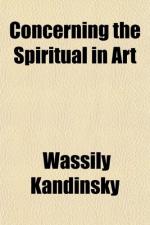He painted these things as he painted human brings, because he was endowed with the gift of divining the inner life in everything. His colour and form are alike suitable to the spiritual harmony. A man, a tree, an apple, all were used by Cezanne in the creation of something that is called a “picture,” and which is a piece of true inward and artistic harmony. The same intention actuates the work of one of the greatest of the young Frenchmen, Henri Matisse. He paints “pictures,” and in these “pictures” endeavours to reproduce the divine.[Footnote: Cf. his article in Kunst UND KUNSTLER, 1909, No. 8.] To attain this end he requires as a starting point nothing but the object to be painted (human being or whatever it may be), and then the methods that belong to painting alone, colour and form.
By personal inclination, because he is French and because he is specially gifted as a colourist, Matisse is apt to lay too much stress on the colour. Like Debussy, he cannot always refrain from conventional beauty; Impressionism is in his blood. One sees pictures of Matisse which are full of great inward vitality, produced by the stress of the inner need, and also pictures which possess only outer charm, because they were painted on an outer impulse. (How often one is reminded of Manet in this.) His work seems to be typical French painting, with its dainty sense of melody, raised from time to time to the summit of a great hill above the clouds.
But in the work of another great artist in Paris, the Spaniard Pablo Picasso, there is never any suspicion of this conventional beauty. Tossed hither and thither by the need for self-expression, Picasso hurries from one manner to another. At times a great gulf appears between consecutive manners, because Picasso leaps boldly and is found continually by his bewildered crowd of followers standing at a point very different from that at which they saw him last. No sooner do they think that they have reached him again than he has changed once more. In this way there arose Cubism, the latest of the French movements, which is treated in detail in Part ii. Picasso is trying to arrive at constructiveness by way of proportion. In his latest works (1911) he has achieved the logical destruction of matter, not, however, by dissolution but rather by a kind of a parcelling out of its various divisions and a constructive scattering of these divisions about the canvas. But he seems in this most recent work distinctly desirous of keeping an appearance of matter. He shrinks from no innovation, and if colour seems likely to balk him in his search for a pure artistic form, he throws it overboard and paints a picture in brown and white; and the problem of purely artistic form is the real problem of his life.
In their pursuit of the same supreme end Matisse and Picasso stand side by side, Matisse representing colour and Picasso form.




